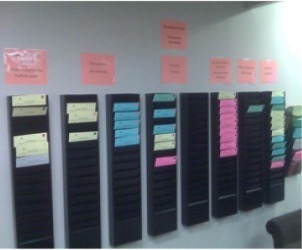Visual management and problem solving routines like "huddle meetings" are two of three crucial pillars of a Lean organization along with flow efficiency. It makes the performance of a process visible “at a glance” – because it is difficult to solve a problem, or to learn what works and what does not when you cannot “see” the process and its performance.
An example of a problem solving routine is a "huddle meeting" which is a time for people to stop the work at a regular, pre-scheduled time to look at what the visual management is telling them about the performance of the process. During the meeting the team assesses what is working well, what is not working well and what they should do differently.
To look at the impact of these two principles, let’s look at what happens when they are not in place.
No Visual Management
If the process is largely invisible, people focus only on the work that is directly in front of them, that they can see. This leads to optimizing small, individual parts of the process, but not the flow from end-to-end—the part that the client feels. This concept is introduced by author and inspirational speaker Niklas Modig in the book, "This is Lean".
If people only see what is happening on their own functional "island", and not how the work flows across all of the islands, they will continue to work in a resource-efficient (not flow-efficient) manner. They miss out on opportunities to collaborate closely to do the job faster, with less effort and less rework. Not only are they working on their own island, imagine they are working inside a tent. They can only see their island. So, instead of seeing how they contribute to scoring a goal for the client, they instead adopt the objective of kicking the ball out of their tent, onto another island.
This is a recipe to maintain the status quo. If you cannot see problems, it is unlikely that you will address them.
Visual management also makes it easier and almost automatic to balance the workload across a team.
This is an example of a physical visual board applied to a recruiting process. Each major step in the process has its own column, and each job to be filled has its own form, with critical information on it, with a different colour for each type of job being filled. As well, each form has a coloured sticker in the top corner, indicating which HR advisor is responsible to work with their client to fill that job.
The idea is that, at a glance, the following things are evident:
- The number of files in the process, showing the overall workload
- How many files are at each step in the process, showing where the work is flowing and where it is piling up
- How many jobs each HR advisor is currently working on.
With this information, it is easy for the team to see what is working well and what is not. For example, it is clear that a certain type of job is piling up at the reference checking stage. This creates an opportunity for team members to re-organize and help open up that bottleneck.
An additional side benefit is that clients can see the status of the job they are trying to fill. In the example in the photo, this led clients to get more involved in the process to move their work forward – exactly what you want in a recruiting process where the supplier (HR) and the client need to collaborate closely to make the work flow smoothly.
Other items that are often seen in visual management:
- Level of team morale
- Who is in / out today
- Who cannot be interrupted and when today
- Training matrix – Who is trained? Who needs training?
- Performance against service standards
- Number and type of incoming errors/rework
Without visual management, it is much more difficult to balance workloads, identify where the bottlenecks and other problems are, and to keep clients engaged and contributing to the work. While physical boards in the workplace are very common, many teams have developed virtual boards to keep them on track. These add great value, and can be surprisingly low-tech.
No Problem Solving Routines
Without a regular routine and habit to turn these observations into action, the visual management is just fancy-looking Lean wallpaper and it is unlikely that the humans in the process will act to solve problems, learn from experience and systematically continue to improve.
Many teams create a simple routine / habit to stop the work on a regular basis to do just that. It often takes the form of “huddle meetings”.
These meetings are designed to:
- make team performance visible
- create accountability
- follow-up on action teams
- get everyone on the same page
- identify problems and assign them - build team's capacity to solve their own problems
- health and safety wellness
Typically, the agenda is organized to take the team through the subject items on the visual board, and address the issues, information and decisions that are most important to the team.
Some elements often addressed in huddle meetings:
- Any health and safety / wellness issues to address today?
- Who is not available to work today? What is our plan to cover for them?
- Since our last meeting:
- What went well? Who wants to provide recognition to another team member today?
- What didn’t go well? What challenges did we face?
- What should we do differently? What did we learn that we can share across the team?
- Progress on issues identified at previous meetings
- How are our processes performing today? What problems do we have today?
- Who is overloaded with work today / who needs help?
- Who has capacity to take on new work today?
- Who cannot be interrupted today and when?
- As well as other issues that are critical to the team, its members and its leaders
To make the meetings efficient, they are “timeboxed” – that is to say that a specific amount of time is allocated to each topic on the agenda. To make the meeting add as much value as possible, the performance measure for the meeting is: the ten minutes spent in the meeting should add more value to each participant than what they would have been doing with that same time otherwise.
Regular routines/habits to address the work not only provide a regular reminder to stop the work and make it better, but also provide a great opportunity to develop the team and create greater participation, engagement and trust.
In this content area, we cover:
Visual Management:
How to:
- Identify the top issues that need to be made visible
- Collect and post data on the performance of core processes with the least amount of effort required
- Create an ongoing process and designate clear roles/responsibilities to keep the visual management updated, and topics relevant
- Choose the simplest technology possible – whether physical or virtual
Huddle Meetings:
How to:
- Identify your long list of issues/information/decisions needing to be addressed, and to sort them into the right tempo of meeting (daily? Weekly? Bi-weekly? Monthly?)
- Create a timeboxed agenda for your huddle meeting, in the form of a huddle meeting guide
- Test the agenda and adjust it
- Train your team to contribute equally, speak efficiently
- Lead the huddle meeting, and train others to lead so that it engages a larger group through rotating meeting leadership
- Create a follow-up routine to address issues raised and learning learned
- Assess and improve the length and return on investment of your huddle
- Overcome common challenges to effective huddle meetings


